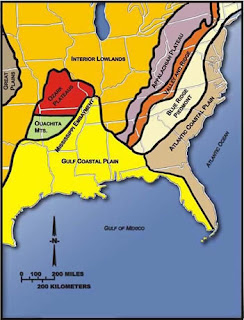Mobile is located in the Gulf Atlantic Coastal Plain that stretches from Cape Cod to Florida and west to the Texas Gulf Coast. The Mississippi River Delta is a prominent feature of this region. Mobile is located more specifically in the East Gulf Coastal Plain exoregion. The East Gulf Coastal Plain ecoregion encompasses portions of five states (Georgia, Florida, Alabama, Mississippi, and Louisiana) and over 42 million acres from the southwestern portion of Georgia across the Florida Panhandle and west to the southeastern portion of Louisiana. Physically characterized by subtle topography, soils derived primarily from unconsolidated sands, silts, and clays transported to the ecoregion by the weathering of the Appalachian Mountains, the ecoregion has a wide range of land forms. These range from sandhills and rolling longleaf pine-dominated uplands to pine flatwoods and savannas, seepage bogs, bottomland hardwood forests, barrier islands and dune systems, and estuaries. The Southeast Coastal Plain ecoregions also share other features, including: a high percentage of land area in wetlands, a dominant role of frequent fire over the majority of the landscape, a diversity of river and stream systems, limited but important karst areas, diverse estuarine and tidal systems and significant large scale disturbance events, such as hurricanes.
Mobile County agriculture is very diverse with greenhouse, nursery, and sod ranked number one in the state and pecan production ranked number two. Other crops grown include cotton, peanuts, soybean, corn, fruits and vegetables, livestock and forage. According to the 2007 census of Agriculture, Mobile County has 876 farms on 113,653 acres with an average farm size of 130 acres. Farm acreage represents 14.4 percent of the total 789,120 acres in Mobile County. Agriculture continues to make a significant contribution to the county economy.
With a latitude and longitude of 30 41’ 39” N / 88 2’ 35” W, Mobile has a humid, subtropical climate, its weather is often hot and humid! Summer months average in the 90s, which makes the winter months mild, averaging in the 50s. Mobile is most known for its rain, however, and is often the wettest city in the country. With yearly rain averages of 66.3 inches, it’s really no wonder the humidity is often 100%!
 |
| Hurricane Ivan 2004 |
The dominant ecological drivers of the terrestrial systems are soils (texture and chemistry), fire frequency, and hydrology. Habitats in the East Gulf Coastal Plain include barrier island systems with annual-dominated beaches, maritime grasslands and scrub, maritime shrub hammocks, and evergreen forests (both broadleaf and needleleaf). These grade through salt marshes to productive estuaries. Inland, longleaf pine woodlands are dominant over most of the landscape, on upland and wetland sites and a wide variety of soils. These pinelands (sandhills, clayhills, flatwoods, and savannas) support a tremendous diversity of plant and animal species; most of them specialized to these systems. For instance, the Southeast Outer Coastal Plain as a whole supports about 1,500 endemic vascular plant species, most of them limited to pineland habitats. Embedded in these pinelands, specialized patch communities such as seepage bogs, treeless“savannas” and “prairies”, and seasonally flooded depression ponds provide rich habitat for plants, amphibians, and invertebrates. Imperiled plant species are concentrated in fire-maintained pinelands (wetland and upland), associated seepage bogs and upland depression wetlands, and barrier island communities. While many imperiled animal species also occur in these communities, there are also significant concentrations in aquatic and bottomland systems, as well as in karstlands.
Sources:
http://www.landscope.org/explore/natural_geographies/ecoregions/East%20Gulf%20Coastal%20Plain/
http://www.aces.edu/counties/Mobile/
http://www.landscope.org/explore/natural_geographies/ecoregions/East%20Gulf%20Coastal%20Plain/

No comments:
Post a Comment